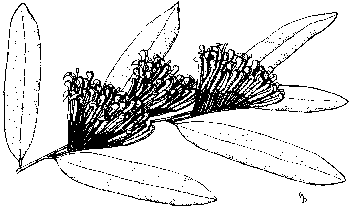
Tree Waratah
David Hockings
If one can claim 'correctness' in application of common names, then Tree Waratah is wrongly applied to Alloxylon flammeum on two counts.
First - Historical
The Queensland Flora volume IV, 1901. "Embothrium wickhamii, Red Silky Oak - Bellenden Kerr Range, Barren River. Flowers in corymbs at the ends of the branchlets or in the leaf axils".
| |
 |
| |
Alloxylon flammeum
Illustration: Cecily Daniels |
Comprehensive Catalogue of Queensland Plants 1909. "Embothrium wickhamii. Red Silky Oak".
I came on the botanical scene in the 1950s at Springbrook and my specimen of a red flowered tree, locally called Queensland waratah or tree waratah, was identified by the Queensland Herbarium as Embothrium wickhamii, under which it was lumped at the time. This tree occurs along the Border Range from Springbrook, Lamington to a reported sighting near Rathdowney. It also occurs in a similar moist habitat in New South Wales where it is known as Dorrigo waratah.
As botanical science advanced, it became recognised that Embothrium was restricted to South America and the Queensland plant(s) were placed in Oreocallis and the species wickhamii was broken up into O.pinnatum and O.wickhamii.
I had grown a third species at Springbrook in the 1950s from seed collected on the Atherton Tableland.
In due course Oreocallis became Alloxylon with A.pinnatum applied to the southern species, A.flammeum to the large showy species from the Tableland and A.wickhamii to the lesser known species from the Tableland and Bartle Frere.
Secondly - Botanical
The waratah, Telopea, produces flowers in a terminal 'head' - florets densely clustered evenly around a short, terminal, erect, persistent and woody rachis. Alloxylon pinnatum produces its flowers in the same manner, but without the large basal bracts that are usually a feature of Telopea flowers. The short, terminal, erect, woody rachis is persistent.
Alloxylon flammeum produces its flowers on mostly one-sided dense spikes in the upper leaf axils. The rachis is not woody and is not persistent. There is no structural resemblance to a Telopea or an A.pinnatum inflorescence.
A.pinnatum is not difficult to grow on deep red ex-rainforest soil. My oldest tree bears 300 to 400 flower heads each year. It seems to be getting earlier and now flowers in October/November.
Nurseries seem to have clung to the name 'tree waratah' as a selling point.
From SGAP Region 'Bulletin', September 2005.
Photos: Keith Townsend; Brian Walters
Australian Plants online - 2006
Association of Societies for Growing Australian Plants
|